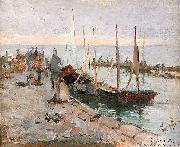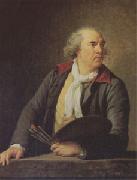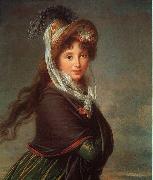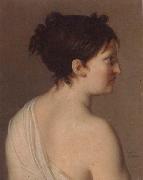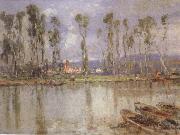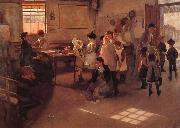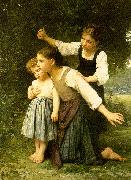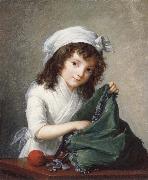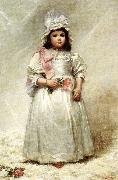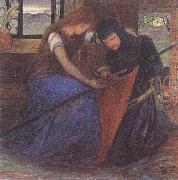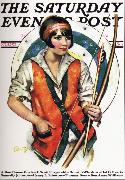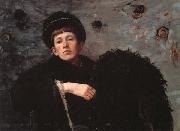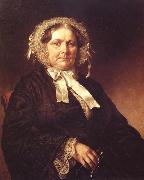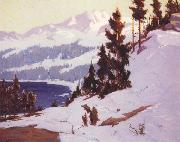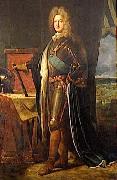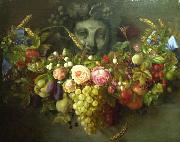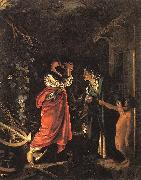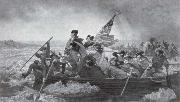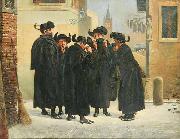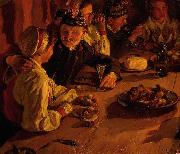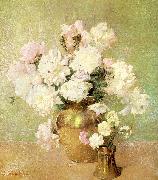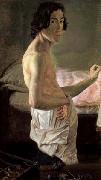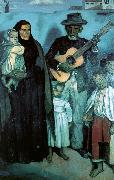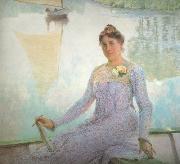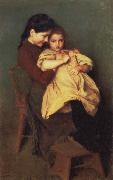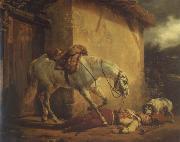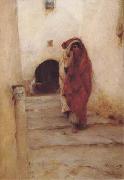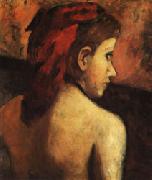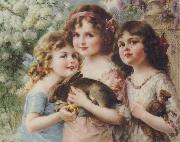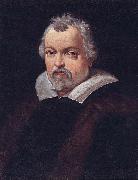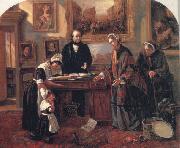|
|
|
|
|
|
|
|
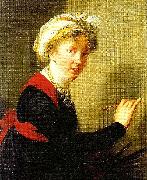 |
elisabeth vigee-lebrun
|
|
Élisabeth-Louise Vigee-Le Brun, född 16 april 1755 i Paris, död 30 mars 1842 i Louveciennes, 20 kilometer väster om Paris, var en fransk målare som i huvudsak målade porträtt.
Vigee-Lebrun utförde tilldragande, idealiserande porträtt och var för en tid hovmålare hos drottning Marie Antoinette. Vigee-Lebrun var tvungen att lämna Frankrike pågrund av den franska revolutionen 1789 och efter det var hon verksam i Ryssland, Italien och Storbritannien. Efter att Napoleons kommit till makten återvände hon till Frankrike. Hon besökte Schweiz 1807 där hon i Geneve blev invald som hedersmedlem i Societe pour l'Avancement des Beaux-Arts.
Vigee-Le Brun lämnade ett arv av 660 porträttmålningar och 200 landskapsmålningar. Dessa finns i privata samlingar i Europa och USA men även i stora museer som Eremitaget, National Gallery i London, Metropolitan Museum of Art i New York och National Gallery of Art i Washington, D.C.. |
|
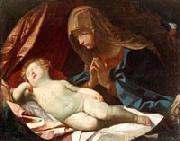 |
Elisabetta Sirani
|
|
(8 January 1638 -25 August 1665) was an Italian Baroque painter whose father was the painter Giovanni Andrea Sirani of the School of Bologna
She was born in Bologna. By age 17 she was a full-fledged engraver and painter and had completed over ninety works. By the time she died at the young age of 27, she had added at least eighty more to her repertoire. Besides being an independent painter by the age of 19, Elisabetta Sirani also ran her family's workshop. When her father became incapacitated by gout, she was burdened with having to support her parents, her siblings and herself, entirely through her art. The stress created by such heavy responsibilities may have been the cause of her early death. It is estimated that in all she produced some 200 paintings, drawings, and etchings. She painted themes such as the Virgin and Child, self portraits, and many more.
Elisabetta Sirani used dramatic light and great movement in her work, which classified it in the Baroque style. She painted many of her larger scale and heavy-themed works publicly and in front of large (and adoring) crowds of on-lookers. Sirani's portraits, mythological subjects, and especially her images of the Holy Family and the Virgin and Child, gained international fame. |
|
|
|
|
|
|
|
|
|
|
|
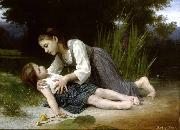 |
Elizabeth Jane Gardner
|
|
(October 4, 1837-January 28, 1922) was an American academic and salon painter, who was born in Exeter, New Hampshire. She was an American expatriate who died in Paris where she had lived most of her life. She studied in Paris under the figurative painter Hugues Merle (1823-1881), the well-known salon painter Jules Joseph Lefebvre (1836-1911), and finally under William-Adolphe Bouguereau (1825-1905). After Bouguereau's wife died, Gardner became his paramour and after the death of his mother, who bitterly opposed the union, she married him in 1896. She adopted his subjects, compositions and even his smooth facture, adopted them so successfully that some of her work might be mistaken for his. Gardner's best known work may be The Shepherd David Triumphant (1895), which shows the young shepherd with the lamb he has rescued. Among her other works were "Cinderella," "Cornelia and Her Jewels," "Corinne," "Fortune Teller," "Maud Muller," "Daphne and Chloe," "Ruth and Naomi," "The Farmer's Daughter," "The Breton Wedding," and some portraits.
|
|
|
|
|
|
|
|
|
|
|
|
|
|
|
|
|
|
|
|
|
|
|
|
|
|
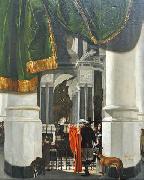 |
Emanuel de Witte
|
|
(1617 - 1692) was a Dutch perspective painter. In contrast to Pieter Jansz Saenredam, who emphasized architectural accuracy, De Witte was more concerned with the atmosphere of his interiors. Though few in number, de Witte also produced genre paintings.
De Witte was born in Alkmaar and learned geometry from his father, a schoolmaster. He joined the local Guild of St Luke in 1636. After a stay in Rotterdam, he moved to Delft and studied with Evert van Aelst. In 1651 de Witte settled in Amsterdam where his first wife, Geerje Arents, died in 1655. He then married a 23-year-old orphan, Lysbeth van der Plas, who exercised a bad influence on de Witte's adolescent daughter. In December 1659 both were arrested for theft from a neighbor.Lysbeth, pregnant, had to leave the city for a period of six years; she lived outside the city walls and died in 1663.
Following the arrest of his wife and child, de Witte was forced to indenture himself to the Amsterdam notary and art dealer Joris de Wijs, surrendering all of his work in exchange for room, board, and 800 guilders annually. De Witte broke the contract, was sued by the dealer, and forced to indenture himself further as a result. Several patrons provided de Witte with support, but these relations did not work out well, for he tended to shout at his clients and at people watching him at work in churches. Records tell of his gambling habit and a fight with Gerard de Lairesse. According to Arnold Houbraken, after an argument about the rent, de Witte hanged himself from a canal bridge in 1692. The rope broke and de Witte drowned. Because the canal froze that night, his corpse was not found until eleven weeks later
|
|
|
|
 |
Emanuel Leutze
|
|
historical painter, born in Gmund, Wurtemberg, 24 May, 1816; died in Washington, DC 18 July, 1868 |
|
|
|
|
|
|
|
Emil Barentzen
|
|
Emilius Ditlev Bærentzen, usually known as Emil Barentzen, (30 October 1799, Copenhagen - 14 February 1868, Copenhagen) was a Danish portrait painter and lithographer, active during the Golden Age of Danish Painting.
Born in Copenhagen on 30 October 1799, Barentzen served an apprenticeship at the pharmacy in Nykobing Sjælland but then travelled to Christiansted on the then Danish island of St. Croix in the West Indies where he worked in one of the government offices. Five years later he returned to Denmark and, after qualifying as a lawyer, moved into painting which until then he had practiced as a hobby. In 1821, he entered the Danish Academy where he studied under Christoffer Wilhelm Eckersberg. He was awarded the little silver medal in 1826 and the large silver medal the following year. He soon became one of Copenhagen's most popular portrait painters. His paintings were characterized by an elegant but sober style, free of psychological trimmings in accordance with contemporary practice. One of his most successful works is the portrait of Soren Kirkegaard's fiancee Regine Olsen (1840).
In 1837, he began to specialize in lithography with H.L. Danschell who managed his deceased father-in-law's oilcloth factory where stones were used to colour the fabric. This led to the founding of a lithographic company, Emilius Bärentzen & Co.s litografiske Institut, which later became Hoffensberg, Jespersen & Fr. Trap. Bærentzen made lithographs of many of the period's most important figures. He continued to work both as a lithographer and artist until 1866 when he painted the portraint of Cosmus Bræstrup for the Freemasons lodge in Helsingor. He died on 14 February 1868. |
|
|
|
|
|
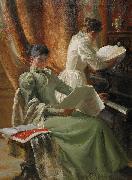 |
Emil Lindgren
|
|
painted Interior med musicerande kvinnor vid pianot in 1893 |
|
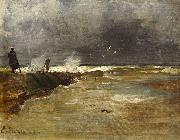 |
Emil Neumann
|
|
painted Strandspaziergang bei Wellengang in 1890 |
|
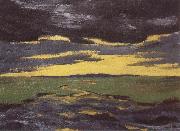 |
Emil Nolde
|
|
German Expressionist Painter, 1867-1956 |
|
 |
Emil Orlik
|
|
(July 21, 1870 - September 28, 1932) was born in Prague, which was at that time part of the Austro-Hungarian Empire, and lived and worked in Prague, Austria and Germany. He was a painter, an etcher and lithographer.
In 1905 Emil Orlik moved to Berlin and took a post at the "School for Graphic and Book Art" of the Museum of Decorative Arts (Kunstgewerbemuseum), now part of the Berlin State Museums.
|
|
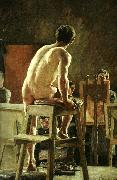 |
emil osterman
|
|
male model and pupils. ca. 1892
royal academy of fine arts |
|
|
|
|
|
|
|
|
|
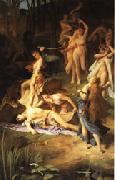 |
Emile Levy
|
|
Paris 1826 - Paris 1890.
French Academic Painter, 1826-1890.
Studied under François-Edward Picot and Abel de Pujol. |
|
|
|
|
|
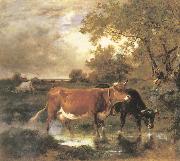 |
Emile Van Marcke de Lummen
|
|
1827-1890
Emile van Marcke was born in S??vres - into a family of artists. His father was Jean-Baptiste (1797-1848), the eldest son of Charles van Marcke and a painter who specialized not only in landscape and animal paintings, but also works on porcelain. |
|
|
|
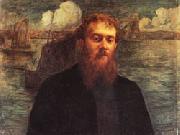 |
emile-Rene Menard
|
|
(1861 - 1930) was a French painter born in Paris. From early childhood he was immersed in an artistic environment: Corot, Millet and the Barbizon painters frequented his family home, familiarizing him thus with both landscape and antique subjects.
Menard studied at the Academy Jullian from 1880 after having been a student of Baudry, Bouguereau, and Henri Lehmann. He participated in the Salon of the Secession in Munich, and the Salon de la Libre Esthetique in Brussels during 1897. Several personal exhibitions were also devoted to him at the Georges Small Gallery. In 1921 he exhibited in the Twelfth Salon along with Henri Martin and Edmond Aman-Jean. Galleries in Buffalo, New York and Boston, Massachusetts exposed Menard and his art to the United States. However, the numerous commissions that Menard received from the French government crowned his career; for example, the cycle for the Hautes Etudes e la Sorbonne, the Faculte de Droit, and the fresco Atoms for the Chemistry institute, and finally the Caise des Depôts in Marseilles.
Menard's art allies a rigorous, clear classicism with a diffuse and dreamlike brushwork. In 1894, Victor Shoe wrote of Menard in l' Art et la Vie (Art and Life): "visions of a pacified, bathed nature, of dawn and of twilight, where the soul seems to immerse itself in the innocence of daybreak, and breathe the divine anointment that comes with the dawn."
|
|
|
|
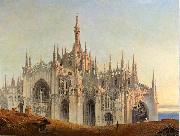 |
Emilio Magistretti
|
|
(Milan, 1851 - 1936) was an Italian painter.
Magistretti studied at the Brera Academy of Fine Arts from 1871 to 1875 under the guidance of Francesco Hayez and then accompanied him on his Italian journey of 1879. He worked initially in a range of different areas, from genre scenes to religious subjects and perspective painting, and successfully tried his hand at painting portraits, animals and landscapes at the turn of the century. He began to establish his reputation as an artist in 1880, when he was awarded a prize by the Ministry of Education, and became well known as a painter of moderately naturalistic portraits particularly appreciated by the middle-class establishment. An autobiography richly illustrated with reproductions of his most celebrated works was published in 1926.
|
|
 |
Emily Carr
|
|
Canadian Expressionist Painter, 1871-1945 |
|
|
|
|







